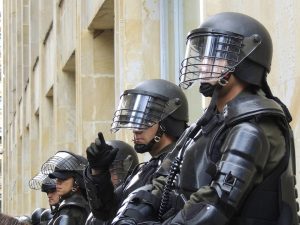
Collectively speaking, there are many of us who have been preparing for emergencies and have read our fair share of prepper fiction and watched enough apocalyptic thrillers to know that the higher the population density, the more dangerous it can be in a disaster. As well, when resources like food and fuel have to be transported from outside the city limits, then your survivability rate lessens. So what about those who have to live in the city? Should they just stop prepping all together? Would they stand a fighting chance at surviving?
According to the last census, 80.7 percent of the U.S. population lives in urban areas. In fact, many choose to live the higher populated areas because of better paying jobs and better school systems, so the probability of a shtf event happening while you are in the city is likely. As well, because many commuters spend a large majority of their time away from their homes, I recommend having these 20 items on hand to get you back home.
In an interview by Rory from The Daily Coin, he asked if it is possible to live out a shtf scenario in an urban setting. The answer is yes, but for a majority of us, we must ask ourselves if we are up to the challenge. Because while I do believe someone could get by in an urban setting, it could prove to be more challenging for the Average Joe.
Urban Survival – Is It Even Possible?
If you are forced to stay in the city after a disaster occurs, all is not lost. I do believe urban survival is possible, but you may need to get creative. Ultimately, being able to survive in an urban setting during a major ordeal depends on multiple factors: specifically, the type of disaster, if basic infrastructure is still up, where you are located, what you have with you and your skill sets. Moreover, I believe that whether you are surviving in an urban setting or a rural one, you need the same things for survival: food, water, shelter, protection (sound familiar?). The difference is you will need to rely more on your skills and ingenuity in finding opportunities to use to your advantage in a post-disaster city. In both scenarios, rural and urban survivors will also have to find a way to carry on for long durations. That is, when your short-term reserves are tapped out, what’s your long-term plan?
Above all, the population density will be your greatest threat and your resources will quickly be depleted. If you are not familiar with Selco’s story from SHTFSchool.com, he survived in an urban setting and tells his story and shares ways that he and others survived on his website. Some of the critical needs he outlines are:
Food – No city can feed it’s people on its own and when the supply trucks stop running, supplies will quickly be depleted. It is wise to have food on hand. I outlined 25 must-have versatile foods for your pantry.
As well, I highly recommend storing a variety of heirloom seeds. These can be to grow sprouts for emergency nutrition and for gardens for long-term food sources. You could also plant edible flowers. Not only will they be lovely to look at, but they will provide sustenance when you need it the most. Alternatively, if you can locate food packing plants or warehouses in your city, that may be a good place to allocate additional food reserves if yours runs out. This article can provide information on foraging for weeds.
Water – Municipal water sources can become tainted and it will be up to you to locate water sources. Water could look crystal clear and still contain very dangerous contaminants. – so avoid this all together and make sure you have some water stored away. Your skills will come in handy here if you are actively practicing how to survive. Here are five different ways to find water when there is none to be had. As well, consider having a map on hand of water sources in close proximity to you.
Fuel – Due to so many who are getting out of dodge and leaving the city, the fuel stores will quickly be depleted. As well, this could be problematic for running your generators. Many preppers prefer to have some alternative fuel on hand, or even biomass briquettes. Make sure you follow the proper safety guidelines for storing fuel, especially those who live in apartments.
Many suggest solar panels as a good power alternative. While I like this idea, I think it can also draw unwanted attention, so further security measures should be put in place to hide the solar panels from view.
Power – The failure of the power grid will prevent things from getting back to normal. When the majority of the population realize things aren’t going to change any time soon, and the above listed items aren’t available, there will be breakdowns to the level of social collapse. Many feel this very reason is why it’s important to be ready to bug out on a moment’s notice. If you are caught in this, it could be very dangerous.
What You Will Be Up Against
While it is entirely possible to survive in the city, you need to know what you will be up against. I realize that I am painting a very bleak picture, but those who stay behind and choose not to bug out are either under prepared, trapped in the city or have enough skills and know-how to make it on very little stored resources. The latter will not be the majority. Therefore, be prepared for roaming gangs, thugs and desperate individuals who have resorted to a more primal version of themselves. They will do what they need to in order for their needs to be met. If they haven’t eaten in days, they will smell your food from miles away, so you need to know how to mask the smells of your food or you could be welcoming unwanted visitors whose primary focus is to take what you have.
Security will be crucial in surviving in an urban setting and having a group you can depend on will make it all the more secure. Many neighbors and friends living in close proximity will band together and help to fortify the homes or find a suitable location in a higher location so you can get a bird’s-eye view of the scenery. One aspect that the city offers is a plethora of building materials to use for fortifying a home. If you start looking for fortifying plans now, you will have a better idea on what materials you will need. I also cannot stress how important it is to have a means of protecting yourself. If someone kicks in your door, they aren’t only looking for a cup of sugar. Having a firearm and knowing how to use it could make all the difference in the world.
As well, having a keen grasp on communication skills with your group to ensure your perimeter is safe and make sure you will have alerts to possible threats. Communication is key and you should have multiple forms of communication, especially if a family or group member ends up being separated. One of the greatest threats we all face in cities are terrorist attacks. They target highly populated cities with dirty bombs and chemical weapons, and what we saw in Brussels that is can happen in peaceful cities, as well. Today it was Brussels. Where will it be the next time they hit America? Protecting yourself is the only option to ensuring your family has what it needs, including gas masks to gauge against chemical and biological attacks.
Start Finding Ways to Think Outside of the Box:
As I mentioned previously, to survive in a post-disaster urban setting, you will need to get creative in the way you work problems. Nothing should be wasted and everything could be used. Trash lying around can be repurposed and fashioned into something more useful. As well, start reading resources that can help you in your future preparations. The following books have great information on this type of survival.
Where There’s a Will, There’s a Way
The human species has always found way to survive and times aren’t all that different. In order to thrive in an urban environment, you need to be aware of what’s stacked against you: the lack of resources, possible threats, roaming gangs and violence. If you can change your line of thinking, utilize key skill sets and become more fluid with the problem, your odds improve.
Tess Pennington is the author of The Prepper’s Blueprint, a comprehensive guide that uses real-life scenarios to help you prepare for any disaster. Because a crisis rarely stops with a triggering event the aftermath can spiral, having the capacity to cripple our normal ways of life. The well-rounded, multi-layered approach outlined in the Blueprint helps you make sense of a wide array of preparedness concepts through easily digestible action items and supply lists.
Tess is also the author of the highly rated Prepper’s Cookbook, which helps you to create a plan for stocking, organizing and maintaining a proper emergency food supply and includes over 300 recipes for nutritious, delicious, life-saving meals.
Visit her web site at ReadyNutrition.com for an extensive compilation of free information on preparedness, homesteading, and healthy living.
This information has been made available by Ready Nutrition

